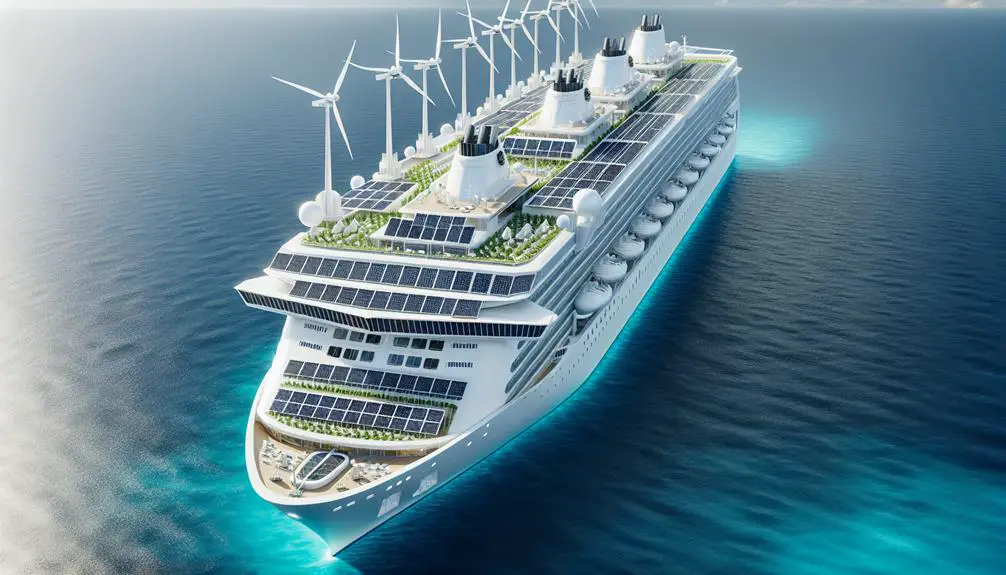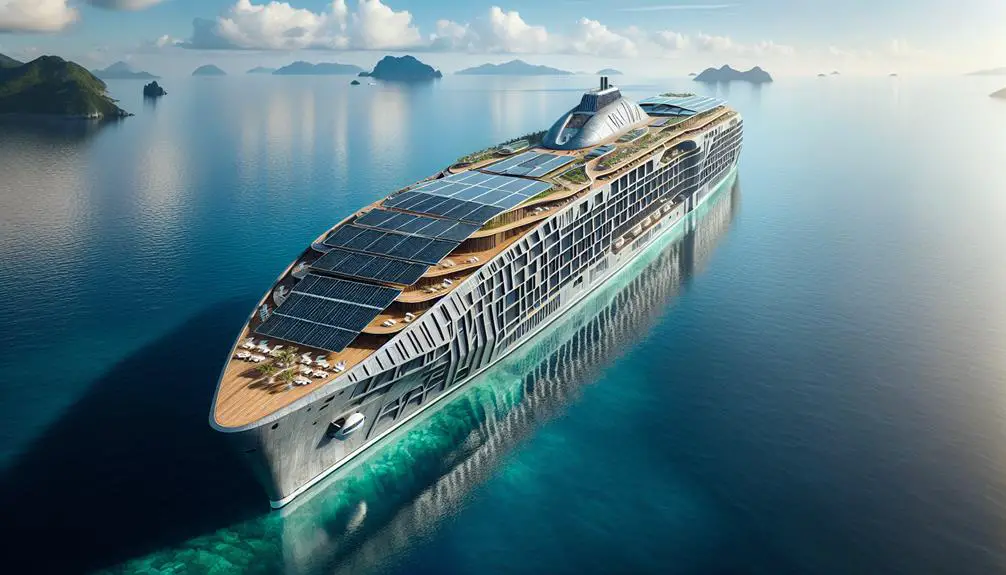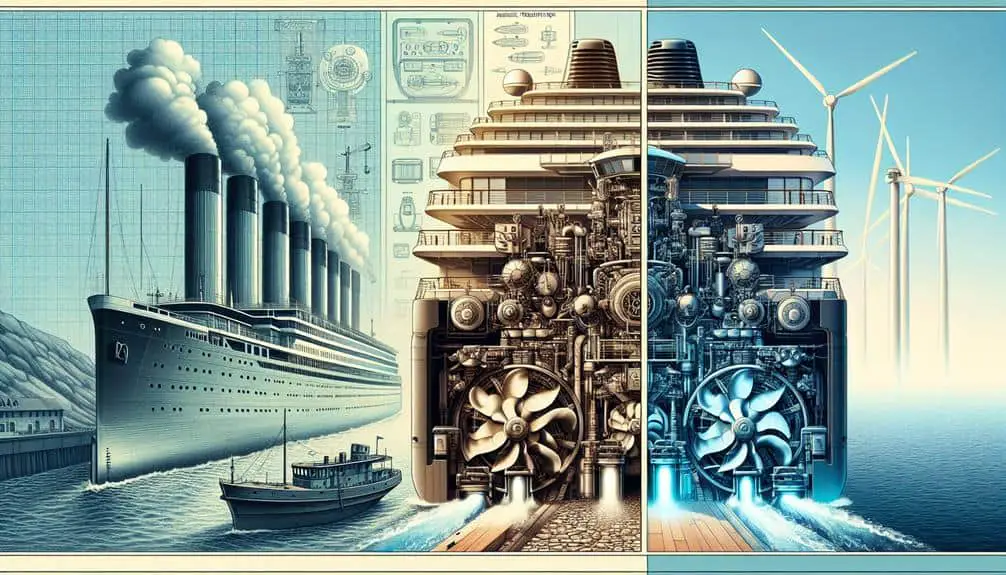To achieve sustainability certifications in cruise ship architecture, prioritize eco-friendly design practices that reduce environmental impact, enhance cost efficiency, and signify a commitment to responsible stewardship. By aligning with leading certification programs, such as those focusing on energy efficiency, waste management, and sustainable materials, you showcase a dedication to environmentally responsible vessel construction. While challenges exist in maneuvering regulations and implementing new technologies, collaborating with sustainability experts and leveraging advanced tools can streamline the process. The future of cruise ship sustainability lies in integrating green technologies like solar panels and wind propulsion systems, promising a more environmentally friendly industry ahead.
Key Points
- Data collection and analysis are crucial.
- Navigate complex regulations and guidelines.
- Collaborate with sustainability experts.
- Utilize advanced software tools.
- Implement sustainable technologies and materials.
Importance of Sustainability Certifications
Embracing sustainability certifications not only enhances the environmental performance of cruise ship architecture but also underscores a commitment to responsible design practices. When considering the importance of sustainability certifications in cruise ship architecture, one can't overlook the significant benefits they bring regarding cost efficiency and reducing environmental impact.
Cost efficiency plays an essential role in the sustainability of cruise ship architecture. By adhering to sustainability certifications, cruise ship designs can incorporate energy-efficient technologies, waste reduction strategies, and innovative materials that not only contribute to lower operational costs but also promote long-term savings. These certifications guarantee that every aspect of the ship's construction and operation is optimized to minimize resource consumption and maximize efficiency, ultimately leading to a more economically viable solution.
Moreover, sustainability certifications directly address the environmental impact of cruise ship architecture. By emphasizing eco-friendly practices, such as utilizing renewable energy sources, implementing efficient waste management systems, and reducing carbon emissions, these certifications enable cruise ships to operate in harmony with the environment, mitigating their ecological footprint and preserving the delicate marine ecosystems they navigate. By prioritizing sustainability certifications, cruise ship architecture can truly embody a greener and more responsible approach to design and operation.
Benefits for Cruise Ship Architecture
To optimize the sustainability of cruise ship architecture, incorporating eco-conscious design practices yields numerous benefits for both the environment and operational efficiency. Cost efficiency is a key advantage of sustainable design in cruise ship architecture. By utilizing energy-efficient systems, such as LED lighting and advanced HVAC technologies, operational costs can be greatly reduced over the long term. Additionally, sustainable materials and construction methods not only contribute to lower maintenance expenses but also enhance the overall durability of the vessel, further reducing lifecycle costs.
Environmental impact is another vital aspect where eco-conscious design shines in cruise ship architecture. Implementing renewable energy sources like solar panels or wind turbines can help decrease reliance on traditional fuel sources, thereby lowering greenhouse gas emissions and minimizing the ecological footprint of the ship. Additionally, integrating advanced waste management systems and water-saving technologies can substantially reduce the vessel's impact on marine ecosystems, preserving the delicate balance of the oceans for future generations.
Ultimately, investing in sustainable design practices not only benefits the environment but also promotes cost savings and operational efficiency in cruise ship architecture.
Leading Sustainability Certification Programs
Optimizing the sustainability of cruise ship architecture involves aligning with leading sustainability certification programs that endorse eco-conscious design practices for enhancing environmental stewardship and operational efficiency. Embracing sustainability trends in cruise ship architecture entails meeting the rigorous criteria set forth by prominent certification bodies such as LEED (Leadership in Energy and Environmental Design) and BREEAM (Building Research Establishment Environmental Assessment Method). These certifications promote eco-friendly designs by focusing on aspects like energy efficiency, water conservation, waste management, and the use of sustainable materials.
LEED certification, for instance, emphasizes reducing the environmental impact of buildings through efficient resource management and innovative design strategies. On the other hand, BREEAM evaluates the sustainability performance of buildings based on categories such as energy, health, materials, and management. By engaging with these leading sustainability certification programs, cruise ship architects can showcase their commitment to creating environmentally responsible and energy-efficient vessels that align with the latest eco-friendly design principles.
Challenges in Obtaining Certifications
Understanding the intricate requirements of sustainability certifications in cruise ship architecture poses significant challenges to architects seeking to enhance environmental stewardship in their designs. One major obstacle is the need for extensive data collection and analysis to meet the strict criteria set by certification programs. This process demands architects to meticulously track energy consumption, waste management practices, and materials sourcing throughout the ship's lifecycle.
Another challenge lies in maneuvering the complex web of regulations and guidelines set forth by different certification bodies. Architects must stay updated on ever-evolving standards and guarantee compliance with multiple frameworks simultaneously. Additionally, the cost associated with implementing sustainable technologies and materials can be prohibitive, especially for smaller cruise ship companies.
To overcome these obstacles, architects can benefit from collaborating with sustainability experts and utilizing advanced software tools for data management. Engaging in early dialogue with certification bodies can also help streamline the certification process. Additionally, fostering partnerships with suppliers offering eco-friendly solutions can make sustainable practices more financially feasible. By proactively addressing these challenges, architects can successfully navigate the complexities of obtaining sustainability certifications in cruise ship architecture.
Future Trends in Cruise Ship Sustainability
Embracing cutting-edge technology and sustainable design principles is paving the way for a new era of environmentally conscious cruise ship architecture. Future trends in cruise ship sustainability are increasingly focusing on integrating eco-friendly technology and renewable energy sources to reduce environmental impact.
One of the key advancements in this domain is the implementation of solar panels on cruise ships. These panels harness the power of the sun to generate electricity, reducing reliance on traditional fuel sources and lowering greenhouse gas emissions. Additionally, advancements in wind propulsion systems are being explored to harness wind power for propulsion, further decreasing the carbon footprint of cruise ships.
Moreover, the integration of innovative waste management systems is gaining prominence. These systems focus on maximizing recycling efforts, reducing single-use plastics onboard, and implementing composting programs to minimize waste sent to landfills. By incorporating these eco-conscious technologies and practices, the future of cruise ship sustainability is promising, aiming to create a more environmentally friendly and responsible industry.
Frequently Asked Questions
What Specific Criteria Do Sustainability Certifications Typically Look for in Cruise Ship Architecture?
To gain sustainability certifications in cruise ship architecture, focus on energy efficiency by using renewable energy sources and optimizing power consumption. Implement robust waste management systems that prioritize recycling and reducing single-use plastics to lessen environmental impact.
How Do Sustainability Certifications Impact the Overall Environmental Footprint of Cruise Ships?
Boosting the overall environmental impact of cruise ships, sustainability certifications drive energy efficiency and waste reduction. Implementing green technologies curbs the carbon footprint considerably, ensuring a more eco-conscious approach to cruise ship operations.
Are There Any Financial Incentives for Cruise Ship Companies to Obtain Sustainability Certifications?
Financial incentives can motivate cruise companies to pursue sustainability certifications. By reducing operating costs through energy efficiency and waste management, companies can not only save money but also minimize their environmental impact.
How Do Sustainability Certifications Affect the Overall Guest Experience on Board Cruise Ships?
Begin on a sustainable journey where guest satisfaction thrives. Design elements crafted with eco-conscious finesse elevate your experience onboard. Reveal a harmonious blend of luxury and environmental stewardship, creating unforgettable memories at sea.
What Role Do Sustainability Certifications Play in Shaping the Future of the Cruise Industry as a Whole?
In shaping the future of the cruise industry, sustainability certifications drive industry innovation and foster sustainable practices. By prioritizing environmental responsibility, these certifications have a global impact, pushing the industry towards more eco-conscious operations.




